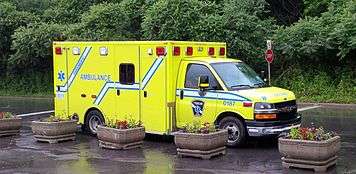Emergency vehicle
An emergency vehicle is a vehicle that is used by emergency services to respond to an incident. These vehicles are usually operated by designated agencies which are often part of the government, but also may be non-governmental organizations and commercial companies specifically authorised by law. Emergency vehicles may be exempted from some conventional road rules in order to reach their destinations in the fastest possible time, such as driving through an intersection when the traffic light is red, or exceeding the speed limit. In some states of the United States, however, the driver of an emergency vehicle can still be sued if the driver shows "reckless disregard for the safety of others."[1]
Types
There are many types of emergency vehicle, dependent on jurisdiction. Some examples of emergency vehicles include:
- Law enforcement
- Firefighting
- Medical
- Air ambulance
- Ambulance
- Motorcycle ambulance
- Nontransporting EMS vehicle
- Other
Equipment
Many emergency response vehicles (especially those of the main police, fire and ambulance services) are likely to be fitted with audible and visual warning devices, which are designed to facilitate their movement through traffic to reach their destination, and to provide some protection on the scene.
Depending on local laws, vehicles on the road may be required to yield the right of way to emergency responders who are using their warning devices. For example, in Utah, when an emergency vehicle is on the road while using its warning devices, all cars are required to pull over to the side of the road, stop, and wait for the vehicle to pass before resuming normal driving, unless doing so would cause an accident or if stopped at a red light/stop sign. Even in areas where no such laws exist, many motorists may allow the vehicle to pass as a matter of courtesy.
Summoning assistance
In many countries, emergency vehicles are usually dispatched from a center that takes calls from an emergency telephone number, such as 9-1-1, 999, 1-1-1 or 1-1-2.
Livery
Colour and design choices reflect several needs, but typically may include:
- Identification of the service – Such as New York State Police or City of Tokyo Fire Department, to which the vehicle belongs and helps identify its purpose to the public and other services. In some areas, the name of the service ("ambulance", "fire" etc.) may be written in reverse lettering on the front of the vehicle to provide a view of the approaching vehicle in a rearview mirror.
- Vehicle ID number – This may be a simple asset tracking number (for maintenance etc.) or may also be the unit number which can be used by the control to identify them. Many vehicles also display their vehicle number on their roof or trunk (boot) lid, to be identifiable from the air.
- High visibility markings – Responding emergency vehicles want to be conspicuous, as do emergency vehicles parked at a scene (so they do not get hit by other vehicles). Many departments use passive visual warnings such as reflective lettering and/or striping to increase their visibility. Other patterns include checker-board (battenburg) or chevrons. For police departments, there can be a competing need for stealth. Police departments can use minimally marked cars with subdued graphics that blend in with the car's body colour, but they can also use unmarked civilian-like vehicles (typically for detectives, undercover investigators, SWAT, and higher-ranking officers), which may be similar to their marked units, or may be entirely different.
- Contact information – There may well be a telephone number written on the side of the vehicle which can be called to summon it. Whilst this also applies in areas where there is a single emergency telephone number, it is especially important where a system of local numbers is in place, or where the service is a secondary service (such as a utility company). In some cases, the vehicle may display an internet address for people to go and find more information about the operator.
See also
- Automobile safety
- ISO 9001 certification
- ISO 14001 certification
- Emergency management
- Emergency vehicle equipment
- Safety car
- Vehicle recovery
